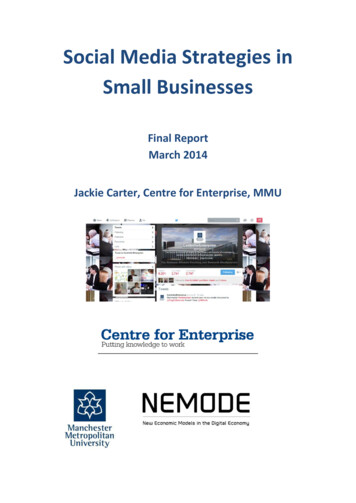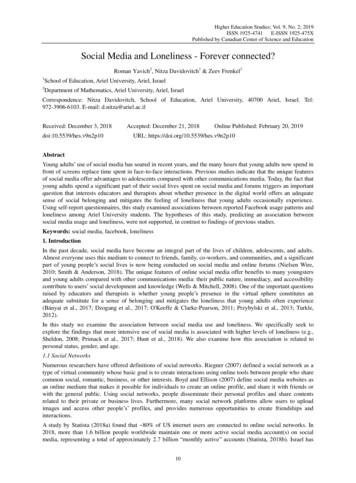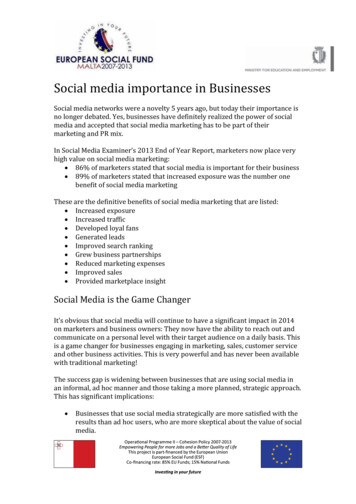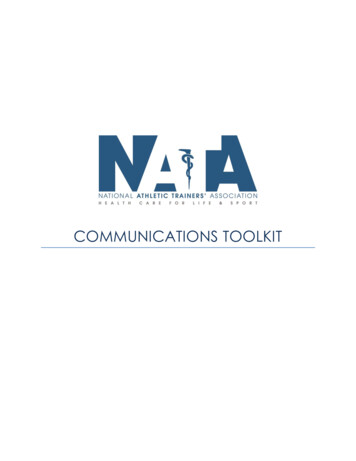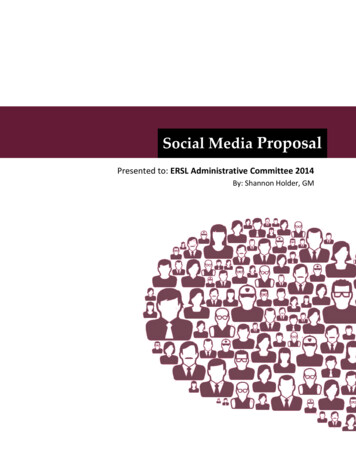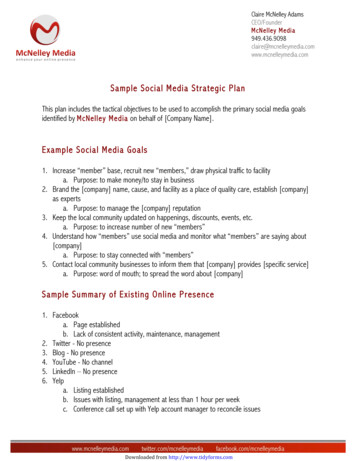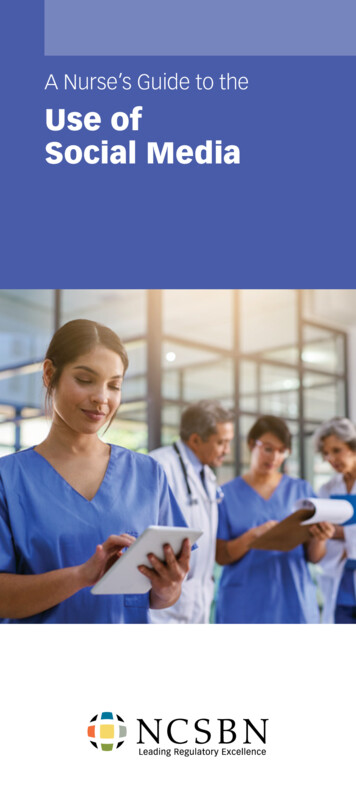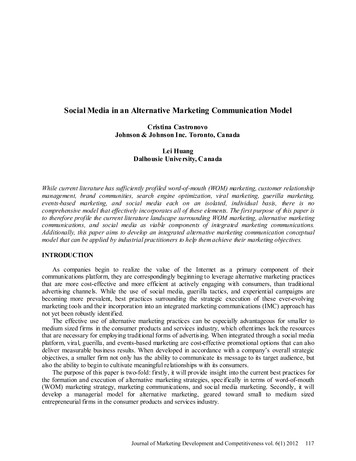
Transcription
Social Media in an Alternative Marketing Communication ModelCristina CastronovoJohnson & Johnson Inc. Toronto, CanadaLei HuangDalhousie Unive rsity, CanadaWhile current literature has sufficiently profiled word-of-mouth (WOM) marketing, customer relationshipmanagement, brand communities, search engine optimization, viral marketing, guerilla marketing,events-based marketing, and social media each on an isolated, individual basis, there is nocomprehensive model that effectively incorporates all of these elements. The first purpose of this paper isto therefore profile the current literature landscape surrounding WOM marketing, alternative marketingcommunications, and social media as viable components of integrated marketing communications.Additionally, this paper aims to develop an integrated alternative marketing communication conceptualmodel that can be applied by industrial practitioners to help them achieve their marketing objectives.INTRODUCTIONAs companies begin to realize the value of the Internet as a primary component of theircommunications platform, they are correspondingly beginning to leverage alternative marketing practicesthat are more cost-effective and more efficient at actively engaging with consumers, than traditionaladvertising channels. While the use of social media, guerilla tactics, and experiential campaigns arebecoming more prevalent, best practices surrounding the strategic execution of these ever-evolvingmarketing tools and their incorporation into an integrated marketing communications (IMC) approach hasnot yet been robustly identified.The effective use of alternative marketing practices can be especially advantageous for smaller tomedium sized firms in the consumer products and services industry, which oftentimes lack the resourcesthat are necessary for employing traditional forms of advertising. When integrated through a social mediaplatform, viral, guerilla, and events-based marketing are cost-effective promotional options that can alsodeliver measurable business results. When developed in accordance with a company’s overall strategicobjectives, a smaller firm not only has the ability to communicate its message to its target audience, butalso the ability to begin to cultivate meaningful relationships with its consumers.The purpose of this paper is two-fold: firstly, it will provide insight into the current best practices forthe formation and execution of alternative marketing strategies, specifically in terms of word-of-mouth(WOM) marketing strategy, marketing communications, and social media marketing. Secondly, it willdevelop a managerial model for alternative marketing, geared toward small to medium sizedentrepreneurial firms in the consumer products and services industry.Journal of Marketing Development and Competitiveness vol. 6(1) 2012117
LITERATURE REVIEWWord-of-Mouth (WOM) Marketing as a Viable StrategyConsumer purchase decisions are highly affected by the opinions and decisions of one’s peers, withpeer-to-peer communication acting as a highly valid and reliable source of product information. Aspreviously summarized by Cheema and Kaikati (2010), word-of-mouth information sharing is a crucialcomponent of the marketing process, as consumers tend to greatly rely on the advice of others whenmaking purchase decisions, especially when purchases are financially or psychologically risky (Gershoff& Johar, 2006). Moreover, word-of-mouth has been shown to be even more effective in influencingpurchase decisions than traditional advertising channels (Godes & Mayzlin, 2004; Herr et al., 1991) andretaining customers over time (Trusov et al., 2009). Consumers are motivated to spread information viaword-of-mouth communications when they are satisfied or dissatisfied with a product (Anderson, 1998)and highly committed to the firm (Dick & Basu, 1994).The advent of the Internet has increased the ability of individuals, and potential future customers, tointerpersonally connect with one another, thereby creating a powerful means through which productinformation can be rapidly disseminated and products be more cost-effectively adopted by the market(Trusov et al., 2009). As a result, marketers can use these interpersonal networks and online communitiesto promote their products and services through electronic forms of word-of-mouth. The most recent andup-to-date WOM model is the Network Coproduction Model, which postulates the idea that both theconsumers and the marketer develop WOM communications together by taking into account the fact thatmarketing messages are no longer unidirectional, largely as a result of the Internet, with messages andmeaning being actively exchanged within a consumer network (Kozinets et al., 2010). In this model,marketers use various new types of tactics and measures to influence the consumer or opinion leader.WOM referrals have also been shown to significantly increase new customer acquisition and boastmuch longer carryover effects than traditional marketing actions as well as higher response elasticities(Trusov et al., 2009). WOM marketing is quickly becoming a driving force behind all strategic marketingcampaigns as the wide variety of social media outlets are increasing in prominence and maturity, and actas crucial resources for informing influencers’ decisions. Tie strength, which refers to the strength of aninterpersonal relationship, has been shown to be one of the most important factors that influence thespread of word-of-mouth communication, with stronger ties resulting in increased reliance on WOMinformation as a basis for purchase (Brown & Reingen, 1987). Source expertise is another importantfactor, with consumers being more likely to trust and believe experts in a particular field (Bansal &Voyer, 2000).In terms of the online world, networks of friends tend to be the best suited for rapid dissemination ofword-of-mouth referrals, as opposed to other types of stakeholder networks (De Bruyn & Lilien, 2008).However, more public forums are also effective, whereby users are connected through some commoninterest and trust others’ opinions as a result of their unique experiences, but do not necessarily know oneanother on a personal level (Dellarocas, 2006). With the majority of WOM marketing moving online, thespread of WOM messages is becoming more heavily influenced by what Huang (2010) refers to aspredispositional ties: preexisting similarities between the source and receiver in terms of their attitudesand interests. Within an online social community, the network must define content in such a way thatprovides users with an enjoyable experience that keeps them coming back and contributing.Social networking sites allow for viral marketing and word-of-mouth promotion to be just as effective– if not more effective – than traditional media outlets because of the high levels of consumer engagementassociated with these alternate forms of Web-based media. Opinion leaders have the ability to greatlyinfluence the beliefs, behaviors, and values of consumers, and they are able to effectively reach masses ofindividuals through blogs and social networks (Acar & Polonsky, 2007). Social networking sites haveprovided marketers with new and efficient ways of reaching deeply into their target market tocommunicate their message (Trusov et al., 2009). Managers can thus encourage positive word-of-mouthcommunication and favorable recommendations among online communities by increasing consumers’118Journal of Marketing Development and Competitiveness vol. 6(1) 2012
commitment to the company; this increased commitment can be achieved by aligning customer valuesand identities with those of the organization (de Matos & Rossi, 2008).There are various scales and tools that have been developed to assess the degree and success of WOMmarketing. Kumar, Petersen, and Leone (2010) have developed a way to measure customer referral value(CRV) using a four-step approach: first, determining whether a consumer would have bought regardlessof referrals; second, predicting the future value of each referred customer; third, predicting the number ofreferrals; and fourth, predicting the timing of customer referrals. This four-step approach is predicated onthe idea that future behavior can be predicted by past behavior, with a marketing campaign potentiallyacting to increase the predicted CRV of a customer. The effectiveness of a WOM program in a socialmedia marketing program, as summarized by Figure 1, can be measured as “word-of-mouth equity”,which gauges the impact of WOM messages on consumers’ decisions to purchase. WOM equity is ametric that takes into account both the impact (the ability of the message to change behavior) and thevolume of messages that are comprised of both recommendations and dissuasions (Harrison-Walker,2001), and how together these factors affect sales and market shares for various products, and theeffectiveness of individual campaigns. (See Appendix Figure 1)Alternative Marketing Communications with Social MediaCustomer Relationship Management (CRM)CRM is one aspect of the marketing mix that benefits from synergistic strategic planning andintegration (Rust & Verhoef, 2005). The use of relationship-oriented interventions to build consumerloyalty, which requires personalized marketing efforts for individual consumers, will only be effective inincreasing a firm’s profitability if these efforts are realized (Rust & Verhoef, 2005). There has been a shiftaway from a product-centric approach to marketing towards that of a customer-centric focus in thatconsumer opinions are largely affected by the combination of messages they receive from marketers andtheir peers. A customer relationship is cultivated by four key actions of a firm: customer acquisition,customer retention, customer growth, and the winning back of customers (Reinartz & Venkatesan, 2008).Effective customer relationship management begins with properly identifying and acquiring the rightcustomer, and accurately estimating each customer’s lifetime value so as to appropriately allocatemarketing resources to relationship development.Overall, effective CRM strategies consist of two key components. The first is firm competence inknowledge management: the collection, analysis, dissemination, and application of customer informationfrom its dynamic customer database. A database provides the firm with the information it needs toeffectively understand, segment, and target its customers in such a way that allows them to moreefficiently allocate resources to creating customer value, devising customer-centric strategies, increasingcustomer loyalty, and consequently increasing firm profitability. More specifically, a customer databasecan provide a firm with recency-frequency information as well as behavior and characteristic informationregarding their customers (Abe, 2009). This type of informationprovides marketers with the tools theyneed to identify active customers, predict purchase patterns, and customize marketing efforts in line withoverall marketing objectives (Rust & Chung, 2006; Sun, 2006).The second is firm competence in relationship marketing: developing and maintaining fruitfulrelationships over time (Arnett &d Badrinarayanan, 2005). Taylor (2010) stresses the importance of longterm coordination of marketing communications in such a way that a consistent message is communicatedat all points of contact between the marketer and the consumer. In order to catch consumers’ attention in acluttered advertising environment, firms must begin to plan for synergy among various communicationand media outlets (Taylor, 2010). The rapid growth in new media, while challenging preexisting businessmodels, also provides opportunities for firms to better understand consumers and manage customerinteractions. Social media platforms have allowed customers to become more active parties in marketingexchanges and these platforms therefore act as a database for marketers, as user-generated content createsan abundant source of customer preference, behavior, and characteristic information (Hennig-Thurau etal., 2010). An increased emphasis on customer relationship management has resulted in significantchanges to how companies market their products and services.Journal of Marketing Development and Competitiveness vol. 6(1) 2012119
Brand CommunitiesA brand community refers to “a group of ardent consumers organized around the lifestyle, activities,and ethos of the brand” (Fournier & Lee, 2009). Strong brand communities are formed on the basis ofunderstanding the individual and social needs of consumers, and connect consumers along these linesthrough affiliation with the brand itself. In order for a brand community to be a success – in that it elicits ahigh level of consumer loyalty, marketing efficiency, and brand authenticity – firms must incorporatebrand communities into their overall business strategies, focus on engineering the community rather thanbuilding the brand, and allow community members to manage and control themselves, defining only theterms of participation (Fournier & Lee, 2009). Brand communities provide a platform through whichconsumers can share information and experiences regarding a certain product or service; this in turnprovides marketers with a means for identifying consumer needs and promoting brand loyaltyinvolvement (Casalo et al., 2008). The effectiveness of a brand community may be measured in terms ofengagement indices, the size of the community, the loyalty garnered from members, and membergenerated ideas for growing the business. Consumer participation in such virtual brand communities ispositively correlated with affective commitment to the brand itself, thereby providing marketers with acost-efficient way to retain customers and strengthen consumer ties (Casalo et al., 2008).Email MarketingThe formation of a permission-based email database can be a valuable tool in CRM, offering firms astraightforward and cost-effective way to acquire customers and strengthen customer relations. Emailprovides marketers with an additional channel for interactively reaching their consumers such that astronger brand identity and loyalty among consumers can be built. Email marketing increases consumers’involvement with a brand, and this increased involvement has been shown to consequently increasepurchase intent and positive word-of-mouth recommendations (Muller et al., 2008). As a result, theeffectiveness of an email marketing campaign can be measured in terms of its delivery and open rates,link clicks, and brand website traffic.Search Engine OptimizationAs consumers continue to move online to obtain product information, search engine optimization(SEO) campaigns are becoming increasingly more crucial to integrated marketing communications. Awell-planned SEO campaign typically begins with a keyword analysis, in which the appropriate keywords are mined and assessed. Website content is then crafted to include the keywords in titles, tags, andother text. Additionally, companies have the option to engage in paid search advertisements, wherein asearch engine is paid to serve text advertisements in response to certain generic or branded keywords(Rutz & Bucklin, 2011). The success of such a campaign can be measured by analyzing website rankingsand traffic, impressions, clicks, and referrals, and these metrics are often made readily available throughsearch engines themselves.Viral MarketingViral marketing encourages word-of-mouth promotion by capitalizing on social networks andcustomers’ desire to contribute to and share message content with their peers. A viral marketing campaignis more likely to succeed when the message content is able to highly resonate with the target audience andappeal to this group’s motivations for sharing information. Consumers who are more individualistic (inthat they want to differentiate themselves from others) and/or more altruistic tend to be those who are alsomost likely to forward online content (Ho & Dempsey, 2008). In general, there are three types ofstrategies that marketers can use to seed a viral campaign: seeding emails, online advertising, or offlineadvertising. Once a campaign has been initiated, it is crucial that marketers effectively manage everystage by analyzing the source of the viral content invitation; if and when a customer accesses the viralcampaign page; and the number of referrals a customer makes to his or her friends (van der Lans et al.,2010).120Journal of Marketing Development and Competitiveness vol. 6(1) 2012
Guerilla MarketingOnline communications channels have also helped in increasing the effectiveness of guerillamarketing campaigns. Levinson (1993) first introduced the concept of guerilla marketing, identifyingthese campaigns as those intended for small businesses. Guerilla campaigns are characterized by their lowcost but extreme effectiveness in building a firm’s reputation through generating buzz and favorableconsumer perceptions. Guerilla marketing is creative, energetic, and flexible. Online venues allow forguerilla marketing messages to be virally spread within blogs and social networks, thereby increasing therelative exposure and effectiveness of the program when compared to offline guerilla venues alone. Theeffectiveness of such a campaign can be measured by such metrics as the attendance at guerilla events, thesales and customer acquisitions that result, and the effects on company’s website traffic.Events-based MarketingEvents can be essential to marketing strategy and marketing communications as they help to buildone-to-one relationships with stakeholders. They can take various forms, including cause-relatedmarketing; sports, cultural, and musical events; lifestyle marketing; and sponsorships. Events allow a firmto build its image and reputation within its industry, as well as establish and nurture important contactswithin its target audience. Moreover, events allow for the circulation of a firm’s message to otherconsumers who are potentially outside of the primary target market, thereby expanding the reach andimpact of the communications. Successful events are characterized by high fit between the brandpersonality and the event itself, as well as the ability to foster a sense of entertainment and excitementamong the audience, with the event audience consisting of members of the firm’s target market (Samu &Wymer, 2009). An experiential campaign’s effectiveness can be measured by its effect on sales, the levelof attendee engagement that results, and the number of new relationships that are fostered.Mobile MarketingMobile marketing is a very recent form of marketing communications that is beginning to grow inpopularity. It has the ability to integrate all forms of media and marketing communications to drive sales,collect CRM data, and add viral value. Mobile marketing can take several forms, including messaging,Wireless Application Protocol (WAP) and the mobile Internet, streaming media, and downloadablecontent. Consumers are readily accessible through this emerging form of new media, with mobilecampaigns having the ability to build a database of consumers that can be mined to better understandconsumer wants and needs, which in turn can help develop highly targeted campaigns (Ferris, 2007).Messaging allows for marketers to extend their reach beyond traditional media to target specificaudiences and encourage immediate consumer action upon viewing an advertisement. It can take the formof mobile alerts, content services, mobile coupons, voting, quizzes, and sweepstakes. WAP and themobile Internet allow marketers to leverage the Internet to deliver content. Streaming media (video,audio, and text) allows for content to be consumed as it is delivered, and can take the form of on-demandstreaming or live streaming. In a mobile marketing campaign, streaming media can be used to delivercommunications messages through subsidized advertisement content, opt-in video ads, or brandedentertainment. Downloadable content is often used to increase consumer engagement with a campaign,acting as a motivator for campaign participation (Mobile Marketing Association, 2007). Mobilemarketing effectiveness can be measured in terms of cost-per-acquisition and the relative level ofconsumer engagement with the various aspects of the campaign. Additionally, mobile marketing providesthe opportunity to leverage social networks to increase engagement with and consumption of digitalcontent. According to Truong and Simmons (2011), consumers are highly inclined to use their mobiledevices to access social media networks. Consequently, a combination of mobile-accessed socialnetworks can be used to push communications and target specific segments of consumers.Journal of Marketing Development and Competitiveness vol. 6(1) 2012121
SummaryThe above-discussed forms of marketing communications and their corresponding evaluative criteriaare summarized in Table 1. Success stories of each type of communication are also briefly identified forillustrative purposes. (See Appendix Table 1)BACKGROUND OF THEORETICAL FRAMEWORKSocial media take advantage of social interaction in order to be distributed. The role of social mediain a company’s overall communications program can have significant business results if implementedcorrectly. With the advent of Web 2.0, advertising has become about engaging in conversation withconsumers, as the most trusted sources of recommendation come through word-of-mouth communication.While a set of hard-and-fast rules for incorporating social media into an overall communicationscampaign does not exist, there are a variety of best practices that can be leveraged to maximize theeffectiveness of a social media program.User-Generated Content in Social MediaAccording to Moran and Gossieaux (2010), a successful social media strategy must begin with anunderstanding of consumer conversations and characteristics. Consumers are more likely to respond to asocial media strategy when they are able to interact with and help others. The ability to foster a socialrelationship between consumers and companies is the most important component of a social mediastrategy. Moran and Gossieaux (2010) explain that a firm must first listen to what existing onlinecommunities are saying about their products and services before a social media strategy can be developed.The success of a social media program is highly dependent upon knowing where the majority ofconversations are occurring.Once these conversations have been identified, marketers must leverage social media to participate inthe conversation and effectively manage their customer relationships. Social media is about fosteringcommunication with consumers rather than a one-sided push of a brand message (Hennig-Thurau et al.,2010). A social media strategy must therefore allow for users to share and contribute to content. A contentstrategy must be developed according to the characteristics of preexisting online consumer communitiesand supported by an integrated online campaign (including a company blog, interactive website, articles,and videos). The social media tools employed in such a campaign should be chosen based on where themajority of conversations about a company are taking place and the social media habits of theparticipants.Social Media Marketing ToolsThere are a variety of tools to choose from when formulating a social media strategy. The network’spower must be multiplied through the integration of various social media tools. The mix of social mediahighly depends on the objectives of the strategy and the trends in social media usage among the targetmarket. A summary of these tools and the corresponding objectives that they achieve can be found inTable 2.Chat RoomsChat rooms are one of the oldest forms of social media, but still have significant value in terms ofdeveloping an effective social media strategy. This is particularly true when a firm is trying to identifywhere conversations are already occurring about their products and services (Moran & Gossieaux, 2010).Incorporating a chat room or discussion board into a firm’s website has the ability to improve customerservice, increase the sense of consumer community, and effectively address consumer needs throughbetter communications and enhanced relationships.122Journal of Marketing Development and Competitiveness vol. 6(1) 2012
TABLE 2SOCIAL MEDIA TOOLS AND THEIR OBJECTIVESToolsChat RoomsBlogsYou TubeFacebookLinkedInTwitterGoogle WaveFour SquarexxxxxxxxxxxxxxxxxObjectivesimprove customer servicecreate sense of communitygarner customer feedbackdrive WOM recommendationsbuild meaningful relationshipsincrease loyaltyharness power of video to increaseembedding of content in other sitesAdvertisingdevelop a communitytarget specific audiencesconnect with professional communitiescustomer engagementconversation propagationincrease collaboration and engagementcrowdsourcingincrease local and mobile connectivityincrease network engagementBlogsA business blog is a powerful and universal way to drive positive word-of-mouth recommendationsthrough the content that a company publishes. Blogs enable companies to establish and build meaningfulrelationships with their target, thereby increasing customer loyalty and the number of third-partyadvocates for the firm. A blog is considered to be a successful marketing tool when the conversation onthe blog turns into online buzz for the firm (Niederhoffer et al., 2007). A business blog can be used as amarketing tool by using it as a forum to offer tips and advice, publish an incentives program thatencourages referrals, hold contests, answer questions, gather and showcase customer stories, andpublically respond to stakeholder comments to maintain the conversation.YouTubeHarnessing the powers of video is critical to the content of many social media campaigns. YouTube isthe second most searched site after Google (McNealy, 2010). Maintaining a YouTube channel for one’scompany allows for videos to also be embedded within a company’s blog, thereby cross-pollinating thesites, which in turn helps to increase website traffic. YouTube also allows for consumer engagementthrough user-generated content (Hennig-Thurau et al., 2010).FacebookFacebook boasts more than 400 million active users and is therefore the most popular socialnetworking site (McNealy, 2010). Not only does Facebook offer various advertising programs, but it alsoenables companies to create their own customized profile and share important information in the creationof their own brand community. Furthermore, Facebook provides companies with the unique opportunityto very specifically target users and spawn a two-way conversation with consumers (Hennig-Thurau etal., 2010).Journal of Marketing Development and Competitiveness vol. 6(1) 2012123
LinkedInLinkedIn is another social networking site that is geared towards a more professional audience. LikeFacebook, there are opportunities to advertise one’s business on this site, develop a profile for a companythat is visible to LinkedIn users, and foster two-way relationships with individual career professionals aswell as other firms (Hennig-Thurau et al., 2010).TwitterTwitter is referred to as a “micro blogging” tool, as posts are limited to 140 characters. Twitter isbeneficial for engaging with customers and propagating the conversation about one’s brand, products,and/or services. It is also ideal for building relationships with key stakeholders (Hennig-Thurau et al.,2010; McNealy, 2010).Up & ComingThe future of social media is likely to be influenced by two key platforms. Google Wave is expectedto have a revolutionary effect on collaboration and engagement once it becomes mainstream. This toolworks in such a way that consumers can actively interact and engage with one another in real-time, andwith marketers. It will enable marketers to create rich brand experiences through crowdsourcing (Laker,2010). Four Square is another new tool that is still in its infancy. It leverages networked activity toconnect individuals on a local and mobile basis, while incentivizing participants through increasedparticipation. Businesses may use Four Square as a means of encouraging engagement within theirnetworks, whether externally or internally (Armano, 2009).Measurement of a Social Media ProgramThe power of an effective social media program must be measured. This can be accomplished bycontinually assessing the level of dialogue and engagement among members. Specifically, relationshipsand content constitute the two sources of social media currency. The effectiveness of a social mediamarketing program must be measured in terms of its ability to generate positive buzz about a firm, as wellas its products and services. This, in turn, should translate into measurable business results for the firm -whether in the form of increased awareness, increased sales, or increased loyalty. Social mediaeffectiveness should not solely be measured in terms of the volume of WOM buzz; rather, the importance,impact, and level of involvement of WOM communication must also be quantified (Dwyer, 2007).Similarly, Stewart and Pavlou (2002) explain that in an interactive context, measuring the structure of theinteraction is crucial for assessing a social media program. While exposure metrics (such as click-throughrates, cost per click, number of hits, and Web site traffic) are ways of beginning to understand how well aprogram is working, interaction-related outcomes that add value and quality to consumer-marketerinteractions must also be a focus of measurement (Stewart & Pavlou, 2002). A wide variety of freeanalytical tools are available for measuring the success of a social media marketing strategy and aresummarized in Table 3 (Barros, 2009; Hall, 2010).Generally speaking, social media can be used to accomplish one of three goals for a business:building awareness, increasing sales, or building loyalty (see Table 4). If the goal is t
advertising channels. While the use of social media, guerilla tactics, and experiential campaigns are becoming more prevalent, best practices surrounding the strategic execution of these ever-evolving marketing tools and their incorporation into an integrated marketing communications (IMC)



